eBay Shopify Integration: Elevate Your eCommerce Game

Opting for eBay Shopify integration is a strategic move that propels sales to new heights. An ability to connect to the giant marketplace eBay from within your Shopify dashboard. What kind of a dream does that sound for any online retailer?
Picture this: Easily handling your inventory, keeping track of orders and synchronizing product listings within eBay as well as Shopify with just a couple of clicks. It is like having a virtual assistant that manages all the little details so you can just concentrate on business growth. Plus, you’ll be able to leverage eBay’s enormous customer base and its widely recognized reputation. Along with that is the intuitive interface and customization features of Shopify.
But we realize that leaping into a world of integration can be troublesome. That is the reason why we are here to help you all through this journey. In this article, we will guide you through the ins and outs of the Shopify integration eBay solution, providing tips on how to make it work best.
1. Why eBay Shopify integration?
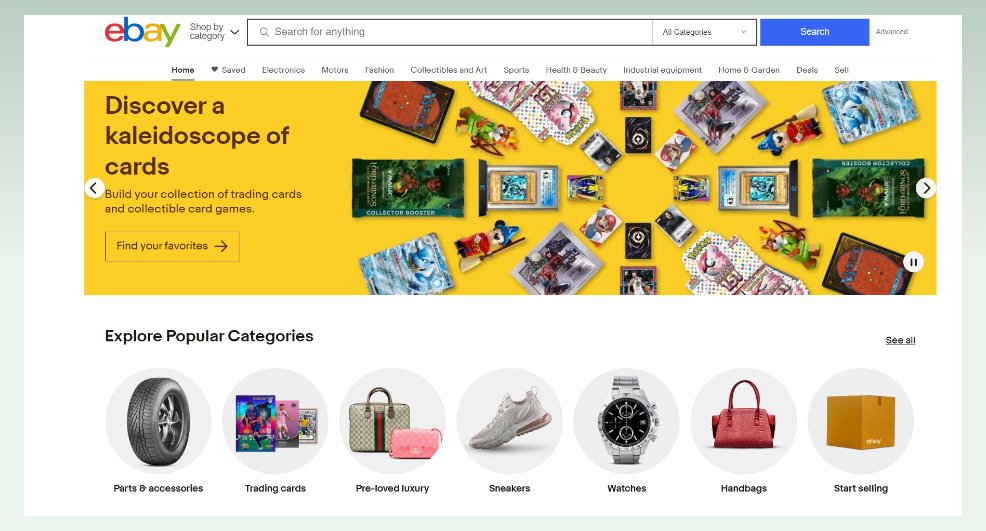
eBay is a widely recognized online marketplace with over 135 million active users – as of 2023. This popular marketplace started from the idea of connecting buyers and sellers on a worldwide scale. The benefits of using eBay are significant as they boast a large customer base, reach out to every part of the globe, and enable the listing and selling of almost anything. However, the marketplace may be fiercely competitive, which is why it could prove difficult for businesses to stand out.

On the other hand, Shopify is an eCommerce website builder that allows businesses to set up their independent online store. It has tools and features for designing or configuring the store, managing inventory, processing payments, or monitoring sales performance. Shopify is easy to use, scalable, and provides dedicated customer support. However, there are ongoing costs involved that could be a deal for startups or small businesses.
So, what are the praises surrounding Shopify’s integration with eBay then?
1.1. Sell on multi-channel
Since eBay is a strong online marketplace, sellers could leverage its brand image and buyers’ trust. Shopify – in contrast to eBay – is not a marketplace, but rather a platform that offers sellers an adjustable online store where they can display their products and manage the store. By presenting your products on several platforms, you make them significantly more visible and accessible to different groups of consumers.
1.2. Enhance operations
Orders and inventory management centrally from Shopify is one pivotal advantage when operating online using the platform. The eBay Shopify integration will also help to avoid manual data entry as the updates on inventory can be made automatically. Along with order management, the integration will save time and reduce the possibility of making errors.
1.3. Gather valuable data
The process of eBay Shopify integration allows sellers to collect important information from both platforms. For example – purchasing patterns and behavior, as well as sales output. Having these data gives sellers an understanding of customer preference trends – from which they can make competent judgments regarding erecting an inventory, a pricing structure, and marketing.
The integration further offers reporting and analytic tools that allow sellers to audit their sales performances over eBay and Shopify simultaneously. Hence, inspiring them to come up with strategies from data that should aid in the growth of the business.
2. How to integrate your eBay store and Shopify store?
2.1. Shopify eBay integration app: Various options
As of December 2022, eBay removed its sales channel app from Shopify. Previously, you could easily integrate eBay with Shopify by adding eBay as Shopify’s sales channel. However, you can still integrate the two quickly and easily – you’ll just need to use a third-party app that would help it function. So, check out the following highly-rated eBay Shopify integration apps that offer various features and prices.
2.1.1. Shopify Marketplace Connect
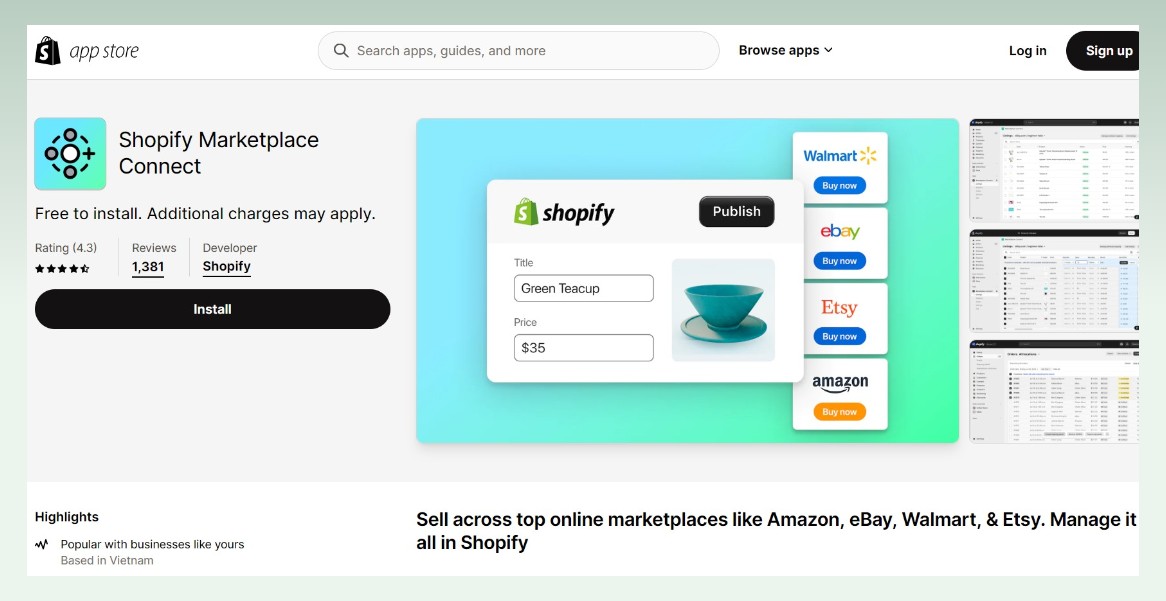
Shopify Marketplace Connect is a free-access integration app that enables merchants to sell products on a range of marketplaces, including Amazon, Walmart eBay, and Etsy.
Previously known as Cosdito, Shopify Marketplace Connect enables store owners to effortlessly link and integrate their product catalog on Shopify with several marketplaces. It allows you to quickly manage and synchronize listings, orders, and inventory, all from within the Shopify platform.
This app also provides unlimited account connections for the supported marketplace and featured currency conversion. Merchants can benefit from the wide reach and ease of selling across marketplace regions and categories.
- Rating: 4.3/5
- Pricing: Free
2.1.2. CedCommerce Importer

CedCommerce is a bulk listing tool that allows Shopify store owners to manage their inventory and sales across both their online store and the eBay marketplace.
The app’s features include the capability to import eBay listings into Shopify, to sync fulfillment details between Shopify and your eBay store, and more. With the app, managing variations is simple, and product administration is straightforward. With real-time information on the completed and ongoing tasks you complete on the app, you also save time.
- Rating: 4.8/5
- Pricing: Free – up to $79/month
2.1.3. eBay Importer by Infoshore
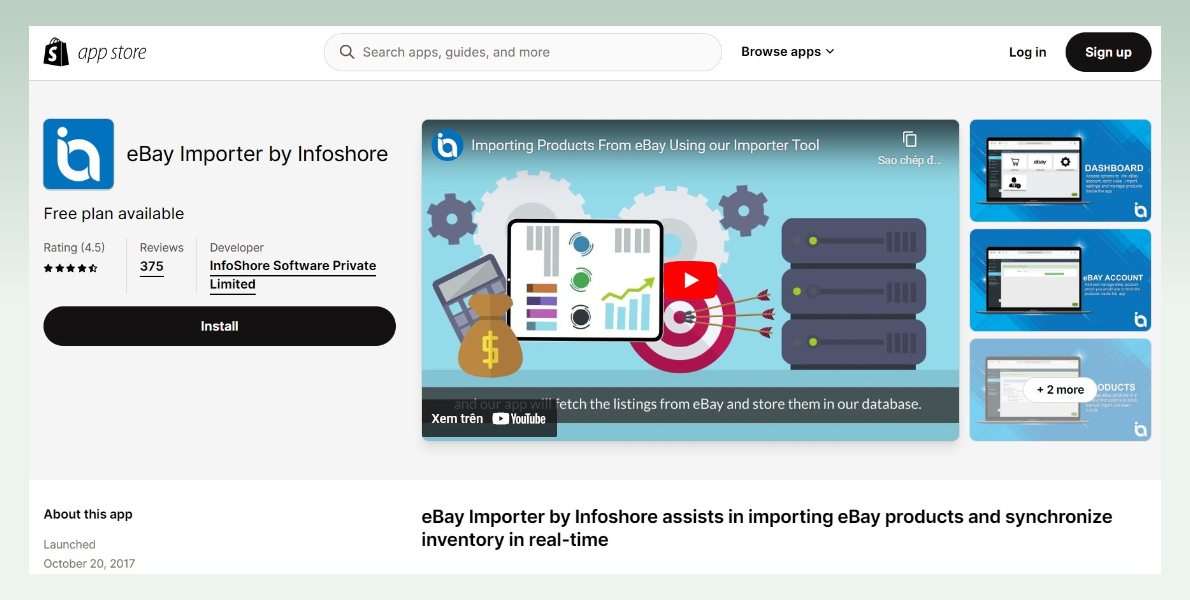
eBay Importer by Inforshore lets store owners easily import eBay listings into Shopify with just a few clicks.
This tool enables you to automatically import all active listings from your eBay seller account to your Shopify store, including high-resolution images and multiple variants. Furthermore, it provides the option to synchronize inventory between eBay and Shopify in almost real-time.
- Rating: 4.5/5
- Pricing: Free – up to $60/month
2.2. Prepare for the integration
Integration is quite a simple process, but before you begin, several other things need to be done in order and ensure everything goes smoothly during the integration process up until later.
2.2.1. Disconnect other apps
Make sure no similar apps for your Shopify store are already running before you install an integration app. Running several integration apps can be confusing for the software and may lead to unsuccessful data integration. If you are selling in various marketplaces, think about using an integration app that supports all the channels necessary instead of using multiple tools.
2.2.2. Prepare your budget
Even if you have already picked a suitable integration app, make sure you check their subscription costs carefully. See if they charge you any other fees that could make you overspend the current operational budget. If your business is working on a tight budget, then you should opt for apps that provide free trials.
2.2.3. Familiarize yourself with eBay’s policies
Shopify is for your own online store, and eBay is a marketplace. They provide various services and hence their policies, terms, and conditions are also varied. Pay attention to these policies, especially the ones regarding forbidden products, listing principles, and required seller behavior.
A good example is CBD (Cannabidiol) products: you’re fine to list CBD-related products on Shopify (with some limitations though), however, eBay forbids virtually all sellers from listing items related to CBD via its marketplace.
2.2.4. Set your pricing, shipping, and return policies
At the same time, if a customer has noticed any differences in prices between eBay and Shopify or assumes that he would need to wait more for his order on one of these channels than another, it damages trust towards your brand as well as user experience.
Ensure that your level of service is consistent across channels. After that, you can initiate the eBay Shopify integration.
2.3. eBay Shopify integration: Step-by-step
Here, we will take the CedCommerce Importer app as an example to have the most intuitive view. If you’re using a different app, this process will be generally the same, so these steps would serve as a means of guidance for you too.
2.3.1. Step 1: Install the integration app
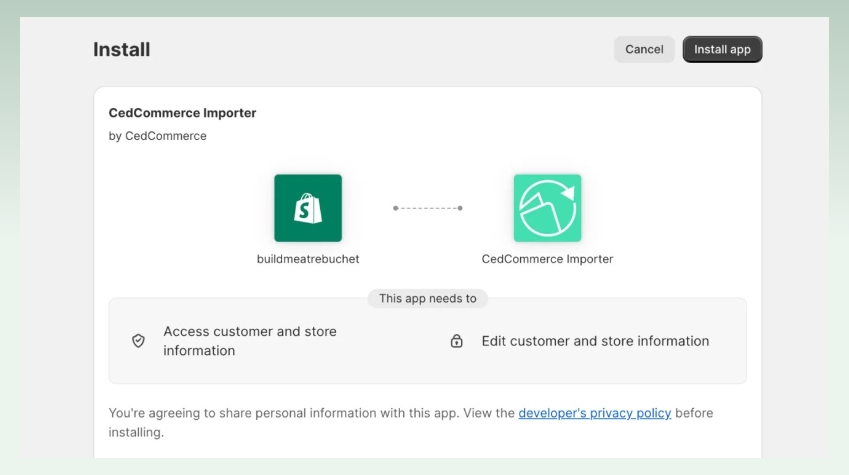
- Choose the relevant app in Shopify’s app store, and click ‘Install’.
- You will be redirected to your Shopify admin dashboard. Then click on the ‘Install app’ button.
- Once you have added the app to your account, you can follow a simple click-through process to meet your requirements.
2.3.2. Step 2: Connect your eBay account

- After registering the app to your store, visit the CedCommerce accounts section and click on the ‘Link your account’ button under eBay Importer settings.
- Click ‘Submit’.
2.3.3. Step 3: Log in to your eBay account and permit access
- You will be redirected to eBay. Log in to your account and complete the eBay setup.
- Once logged in, you will need to allow the app access to your eBay account.

2.3.4. Step 4: Import your products to Shopify
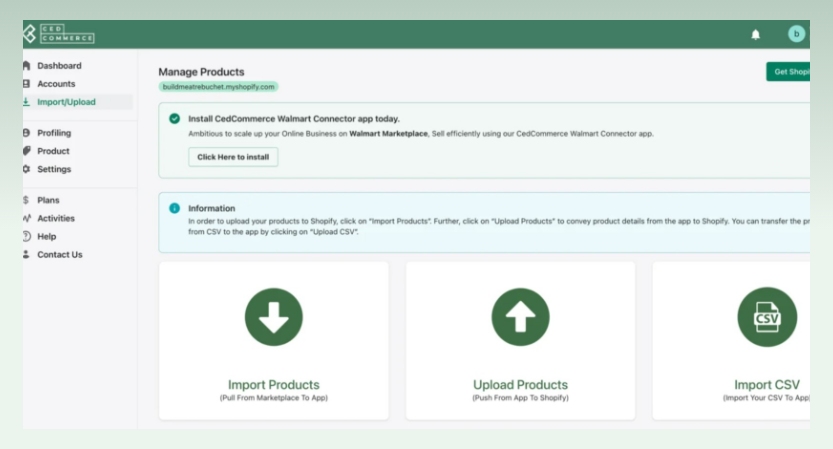
- To start the importing process, navigate into the ‘Import/Upload’ tab in CedCommerce admin.
2.3.5. Step 5: Test your integration
- Execute a test step to ensure that orders do not mismatch between Shopify and eBay.
- Ensure that inventory updates reflect actual differences in product availability to prevent discrepancies.
- Spend some time fine-tuning your settings, checking product listings, and making any necessary changes to improve integration effectiveness.
3. Shopify eBay integration: Troubleshooting common issues
If you have already done your Shopify integration eBay process, then you can proceed with selling on both platforms simultaneously. However, the actual reality is not always smooth sailing, and there are some common challenges that online businesses might face.
3.1. Listing errors
Upon integration, it is possible to observe that you cannot add products onto eBay and instead get either one of any multitude of error messages.
Though there are many reasons for the wrong listing, sometimes it may be due to differences between Shopify and eBay requirements.
So it is worth learning these requirements before integration to reduce errors. Ensure compliance with eBay’s standards regarding product titles, descriptions as well as images.
3.2. Inventory inconsistency
The discrepancies might result in overselling on either platform or both, which is embarrassing and reprehensible for your brand.
Real-time inventory sync is an excellent way to avoid this issue, especially if you opt for a good integration app. But no matter what integration apps you use, it’s still essential to use a manual inventory tracking system during peak sale times.
3.3. eBay categories not fully optimized
Although your Shopify products will most likely fall into the category it is placed in on eBay, sometimes there are inconsistencies. eBay uses category listings as a basis when sorting out results, so focusing on this aspect of integration helps enhance your store’s presence.
Through your integration app, you can automatically set categories to which the products belong. But to properly focus on viability and relevancy for your customers effectively, you should track this process closely enough to make the appropriate manual changes.
3.4. Cross-platform branding
Maintaining consistent branding across eBay and Shopify is essential. Customize your eBay store design to match your Shopify store’s branding. Use eBay listing templates or hire a professional designer to create a cohesive visual identity.
4. Examples of successful eBay and Shopify stores
4.1. Nasty Gal

Nasty Gal is an online fashion retailer with a huge fan base due to its unique styles and designs of edgy, cool clothes. On Shopify and eBay, Nasty Gal makes sure that customers can take a look at their variety of products such as dresses, tops, or accessories without constraints related to the platform they choose.
4.2. Fashion Nova

Fashion Nova is a popular one-stop shop for fashion enthusiasts looking to keep their trends “on trend” without breaking the bank. Fashion Nova operates on Shopify and eBay where it presents its variety of stylish clothes selling stunning dresses, jeans, swimwear, and accessories. The presence of Fashion Nova on various platforms enables the company to ensure seamless shopping for fashion lovers across the globe.
4.3. Pura Vida Bracelets

Pura Vida Bracelets specializes in ethically-conscious jewelry, making bracelets and other accessories by hand from recycled materials. Because Pura Vida Bracelets is available on both Shopify and eBay, it becomes effortless for the customer to search through their wide range of cool products that are full of life significance.
Forming a bridge between customers and artisans around the world, Pura Vida Bracelets offers colorful bracelets, as well as distinctive earrings and anklets in addition to many other handmade accessories.
5. Conclusion
To sum up, the eBay Shopify Integration is a great resource for companies seeking to enhance the reach of their products and multiply sales opportunities. The integration provides several advantages to the sellers by making their inventory and ordering processes more efficient, improving customer satisfaction, and approaching a larger group of customers.
But maneuvering through this process can be difficult, even more so for startups or entrepreneurs planning to step into the online selling realm. Luckily, some useful resources that will assist you in making your integration successful. eComStart serves as a business guide that contains myriads of startup guides. For all the novice and skilled sellers, among others, visit eComStart.io for essential knowledge to provide numerous opportunities for businesses.


